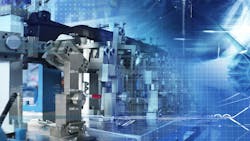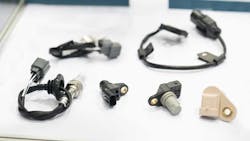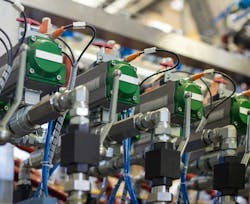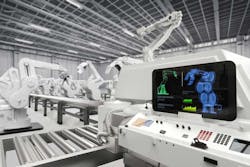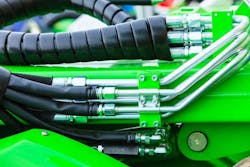Sensors and Software in Motion Control: Key Benefits to Consider
Integration of sensors and software into motion control components and systems is on the rise. Their use has grown in recent years due to the many benefits which can be achieved including collection of performance data and improved controllability, among other reasons.
According to Dave Boeldt, Product Manager for the Bosch Rexroth Corporation, Automation & Electrification division, machine building has become more focused on software than it was in the past. Previously, mechanical functionalities were the priority followed by electrical, and software was a small portion of the machine building process.
“Now everything is starting to be focused on software,” he said. “Software is what gives the machine its connectivity between the shop floor and the IT world.”
Joern Strasser, Business Manager for Speed Sensors at Rheintacho, has witnessed a rapid increase in the number of sensors utilized in customer applications, particularly hydraulics, since joining the company about 10 years ago.
“There are a lot of reasons [for this growth],” he said, “but the main one is there are more tasks required in the mobile hydraulics world.” These include predictive maintenance capabilities, increased safety and efficiency, and the move toward autonomous driving.
READ MORE: Understanding Digitalization and its Use in Fluid Power
Sensors Bring Performance Advantages to Motion Control Systems
Oliver Lythgoe, Chief Marketing Officer at FÉTIS Group, agrees the number of sensors used in hydraulics and other motion control devices is increasing. He said the reason for this is simple. “Everybody who operates machines, sells machines, or rents machines wants them to be easier and safer to operate.”
This requires smoother and more accurate operation, which can be achieved by moving towards a more electronic world through the incorporation of sensors.
Lythgoe noted FÉTIS is seeing increased demand from customers for inclusion of sensors in the company’s hydraulic cylinders. Many are looking for a combination of pressure and position sensors which he said enables new forms of control for faster, more accurate cylinder movements.
Strasser said the more a system gets controlled, the bigger the advantage because the next technological step for many manufacturers in the mobile equipment space is autonomous driving. Autonomous vehicles require a lot of measurements and data collection to ensure accurate and safe operation. “You need to have knowledge about what is going on in the machine and this can be managed by the usage of sensors,” he said.
Today, almost every motion on a machine can be monitored, said August Meyers, Branch Manager for Mobile Automation at SIKO Products Inc. Sensors of various types enable monitoring of rotation, speed, position and other aspects, enabling machine users to ensure components and systems are performing as desired.
Monitoring performance benefits machine productivity as well as safety, which Meyers sees as the number one factor driving increased use of sensors. This includes “protecting operators as they're using a machine, protecting the machine itself from being used in unsafe conditions, and then protecting the environment around the machine so that the machine can't actually get into a situation where it damages things around it,” he explained.
Greater concern is being placed on efficiency than it was in the past, as well, due in part to sustainability efforts. The more efficient a component or system is, the less energy it requires and thus the less fuel consumed, and emissions produced. As electrification and other diesel alternatives gain market share, the need for efficient systems will be even greater to maximize energy use.
The improved control sensors provide can help to improve efficiency. Lythgoe explained that in hydraulic pumps, for instance, the pressurization and pumping of hydraulic fluid can be better controlled through the incorporation of sensors, enabling efficiency gains to be achieved.
READ MORE: How Modern Technology Impacts Hydraulic Systems
How Software is Benefitting Manufacturers
The role of software in motion control systems is varied as it can be used to program the functionality of components and machines, provide connectivity between systems and aid with data collection and analysis.
Strasser noted software is becoming more important for the compilation, calculation and processing of data including that collected by sensors especially as manufacturers work toward development of autonomous driving capabilities.
The advent of Industry 4.0 in the manufacturing sector has also increased software’s role in the collection and analysis of data, aiding performance monitoring and maintenance needs. Bosch Rexroth’s Boeldt said the move to Industry 4.0 brought the ability to get more out of machines by allowing collection of data related to performance of various components.
For instance, motors and drives equipped with sensors “can tell you how much torque the application is using and based off that torque, you can see [in the software] where a motor might be working harder and you can [look at] what is causing this to happen,” he said.
Boeldt said the industry was struggling to promote the concept of data collection and developing predictive maintenance models until COVID-19 which changed the way people worked. Remote connectivity became increasingly more important, requiring greater visibility into production systems and how applications were running.
“This led to the digital transformation,” he said, in which use of the internet of things (IoT) and connectivity to sensors is enabling collection of information and diagnostics to identify areas in which equipment efficiency and productivity is being maintained at a maximum level. And if there are areas which are lacking, those can be determined and corrected as necessary.
According to Boeldt, software is removing the limits out there in the industry by enabling things to be seen in real time and decreasing any latencies that may exist. It is also helping manufacturers quickly and easily add new functionalities to their machines and switch between production applications, enabling better flexibility and scalability.
READ MORE: Software Brings Efficiency Gains and Ease of Use
Best Practices for Integrating Sensors and Software
While there are many benefits provided by sensors and software, understanding how to properly integrate them with motion control systems will help to ensure these benefits are achieved.
Knowing the application in which the system will be used is key. Mobile hydraulics, for instance, are often utilized in harsh environments, requiring use of robust, reliable, field proven technology. “When you think of hydraulics, it is like bull riding in a minefield,” said Strasser. “You have the harshest conditions you can think of; you have dust, dirt, vibrations, unpredictable weather conditions and sometimes the system comes in contact with different kinds of fluids” all of which he said is very aggressive on sensors and other components.
When integrating sensors into hydraulic components and systems, Strasser noted the importance of considering how the sensor will be mounted – whether externally or internally – as well as the space claim available.
Register for the upcoming webinar “How to Select the Right Sensor for a Hydraulic Cylinder” for more details on sensor types and selection parameters to consider.
Lythgoe agrees that taking the environmental conditions into account is important when integrating sensors into hydraulic systems. All components need to have a strong design to withstand not only the environment but also shock loading, vibrations and potential misuse by machine operators.
The second important factor he said to consider is how the data collected by sensors will be used. “What’s the decision you are going to make with that data? What is the value of that decision to each person in the value chain?”
He said there are also questions surrounding criticality which need to be taken into account. “What happens when a sensor fails? Or when it loses accuracy? How's it going to fail? How will information be interpreted? How will it be detected? What's the Plan B? Criticality and safety are fundamental,” said Lythgoe.
Meyers also emphasized safety being a key factor to consider when integrating sensors. He also noted the importance of determining the type of signal output that will be used. “That is contingent upon the type of control systems being used,” he explained. “Are you using EtherCAT, PROFINET, PROFIBUS or IO-Link?” The chosen control system also factors into the other necessary design considerations as well as replaceability, availability, and compatibility across multiple sensor lines he added.
Understanding the application and its requirements is important to the integration of software as well. According to Boeldt, the greater focus on software in today’s machine designs has led to data and monitoring of that data being top considerations to take into account as well as how the data will be collected and analyzed.
Security has also become a major design factor. Boeldt said there are various methods Bosch Rexroth uses to build security features into its software platform to ensure no outside entities can execute machine functions.
“Having a robust cybersecurity plan is really something that's challenging and also needs to be maintained,” said Boeldt. “It needs to constantly be updated so that it can adapt to [new cybersecurity issues as they] come out.”
The use of sensors and software in motion control will continue to grow in the coming years to provide the improved performance and data collection capabilities for which machine owners are looking.
Further automation of systems and machines in a variety of industries will be a strong driver for this continued growth. “There is no going back,” concluded Meyers. “We are in an automation phase…we are going to see more and more automation…[and] the technologies are advancing every day.”
Watch a preview of our panel discussion "The Benefits of Sensors and Software in Motion Control" from which this article is based.
Watch and Learn More!
Information in this article comes from our Engineering Academy session “The Benefits of Integrating Sensors and Software into Motion Control Systems.” Register now to watch the full panel discussion as well as other webinar sessions which are part of “The Value of Sensors & Software in Motion Control” event which goes live June 22, 2023.
You can also watch these and other sessions on-demand when most convenient for your schedule.
About the Author
Sara Jensen
Executive Editor, Power & Motion
Sara Jensen is executive editor of Power & Motion, directing expanded coverage into the modern fluid power space, as well as mechatronic and smart technologies. She has over 15 years of publishing experience. Prior to Power & Motion she spent 11 years with a trade publication for engineers of heavy-duty equipment, the last 3 of which were as the editor and brand lead. Over the course of her time in the B2B industry, Sara has gained an extensive knowledge of various heavy-duty equipment industries — including construction, agriculture, mining and on-road trucks —along with the systems and market trends which impact them such as fluid power and electronic motion control technologies.
You can follow Sara and Power & Motion via the following social media handles:
X (formerly Twitter): @TechnlgyEditor and @PowerMotionTech
LinkedIn: @SaraJensen and @Power&Motion
Facebook: @PowerMotionTech

Leaders relevant to this article:
